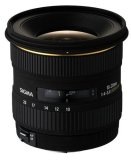 I bought the Sigma 10-20mm f/4-5.6 EX DC HSM
I bought the Sigma 10-20mm f/4-5.6 EX DC HSM ($479 at Amazon right now) as a way into architectural and landscape photography – the 28-105mm I had at the time being way too long on my cropped-sensor Rebel XT.
It’s sturdy, and delivers some amazing shots, but you need to watch out for the distortion.
Wide is good
There are times when there’s nothing to beat a wide angle zoom like this one. Landscapes are the obvious usage, with architectural work (especially interiors) being another sweet spot for the lens, but there are a wider range of subjects that can benefit from a wide-angle than you might think.
Donncha O Caoimh largely uses this lens for his street photography, with great results, and some of the favourite images I’ve taken with it haven’t been traditional landscapes.
Images that include some direction in their composition – leading you into the shot, for example – seem to benefit from the wide angle treatment. As do portraits when you want to show some context.
On the plus side
The Sigma is chunky and built like a tank, with satisfyingly damped zoom and focus rings. It comes with a (not very useful) squareish bag, and a lens hood that you can reverse onto the lens for stowing.
If you’re used to a medium zoom, the first experience of the lens, especially at the 10mm end can be striking – and you’ll find your feet in the shot if you’re not careful.
It’s not fast (minimum f/4 – 5.6), but as most of the time with this lens you’ll want to have as much of the frame in focus as you can, so the wide depth of field doesn’t matter that much.
Because of its wide angle, it’s forgiving of camera shake. The old 1/focal length rule of thumb for safe shutter speed actually seems to hold true here – even on a crop body. I’ve managed some decent handheld shots at 1/25th of a second with no bother, for example.
Straight and level
If, like me, you were buying this lens partly to take some architectural shots, a couple of words of warning. Firstly, especially at the widest focal lengths it suffers from some marked distortion (more details from Ken Rockwell, for example).
In a landscape, that probably doesn’t matter too much, but if you’ve got straight lines (like walls or rooflines) near the edge of the frame, they might start looking very weird.
And not necessarily correctable very easily in Photoshop. For his reason I’d definitely look at the (more expensive) Canon EF-S 10-22mm f/3.5-4.5 USM, which seems to have an almost supernatural ability to counter distortion.
And, though it’s no fault of the lens in this case, if you start tilting the camera slightly to take in the top of a building, for example, the angle is so wide you’ll get some very weird effects quickly.
So keep it level, and ideally on a tripod for those building shots (interiors and exteriors).
Learning curve
The way this lens sees the world is quite different from the way our eyes do, so there’s definitely a learning curve in getting the most from it. As I said above, having some direction in the composition (especially from front to back) really helps.
Sometimes with me, shots that I think will be great with it just turn out to be photos with a lot of stuff in them, while other times it shines when I don’t expect it.
But with the crop factor on many DSLRs making all our lenses longer, there aren’t that many options for going really wide. The Sigma 10-20mm f/4-5.6 EX DC HSM is one I’d definitely recommend, unless its peculiar distortion profile is going to get you into trouble.


